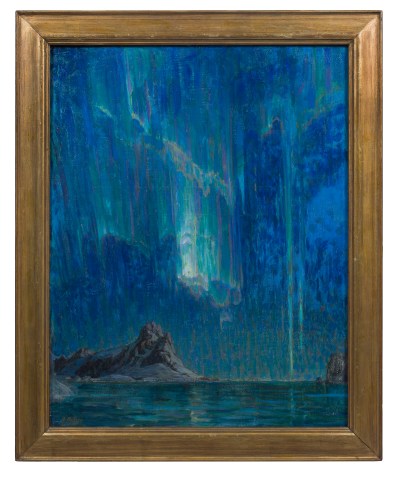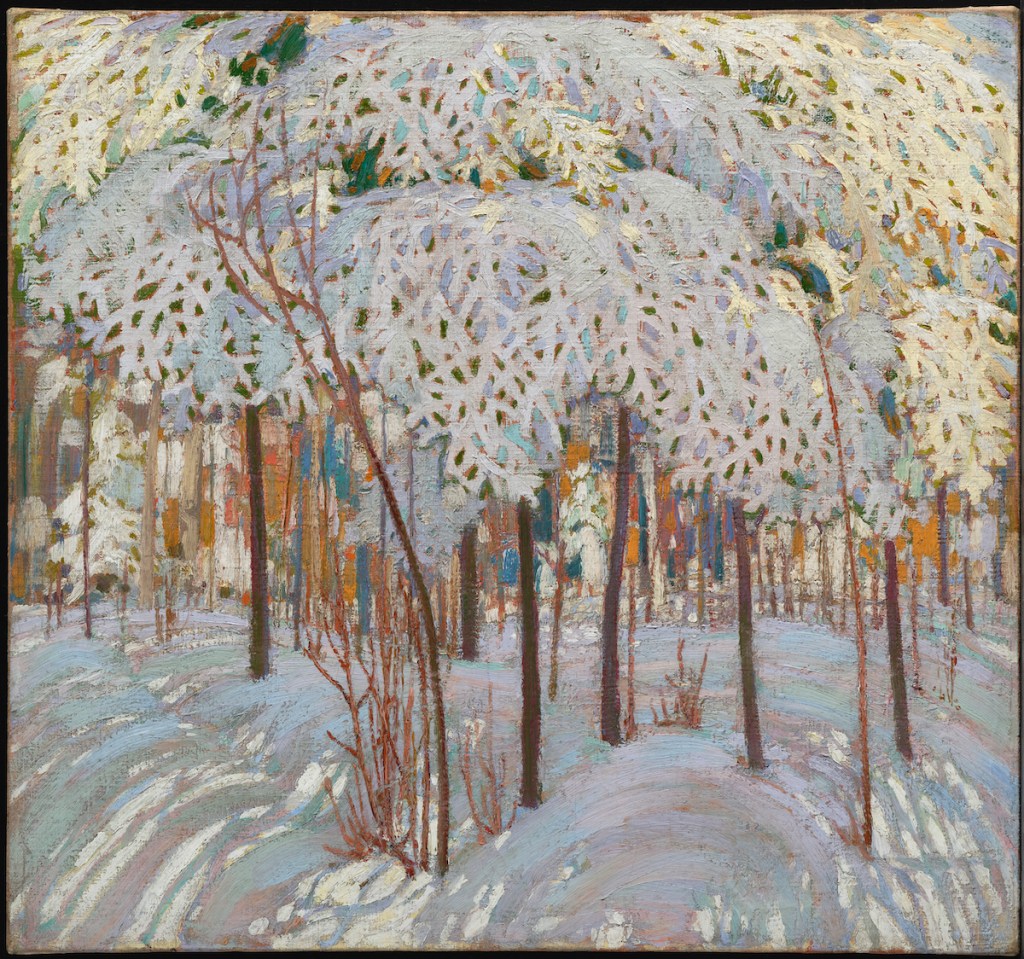“Northern Lights,” on view at the Buffalo AKG Art Museum, proposes a new geography of art, one determined by ecozones rather than national boundaries. The exhibition, which debuted at the Fondation Beyeler in Switzerland, unites pictures of the boreal forest from Scandinavia and Canada made in the late 19th and early 20th centuries. “Boreal,” meaning “of the north,” indicates the high latitudes at which these primarily coniferous forests exist. Dense, cold, and dark from November to March, the region requires a particularly intrepid kind of artist, and the idiosyncratic figures gathered in this show each reveal a profoundly individual relationship to the harsh climate.
Related Articles
Swedish artist Anna Boberg, for example, donned skis, seal furs, and a portable easel to paint outdoors in the Lofoten Islands in Norway. Her work is one of few examples of aurora borealis in the exhibition, and her small studies capture that most fantastical of natural phenomena in jewel-toned oils. Canadian artist Tom Thomson was known to take painting trips in his canoe; that he later drowned in it adds to the mystique of his images of a grand and inhospitable nature.
The seeds of the show were, remarkably, planted in Buffalo over 100 years ago when Boberg’s work, along with that of several other featured artists including Edvard Munch, was on view in an “Exhibition of Contemporary Scandinavian Art” at what was then called the Albright Art Gallery. Two Canadian artists, Lawren Harris and J.E.H. MacDonald, traveled to see it, and were so struck by what they saw that they founded a movement known as the Group of Seven, dedicated to capturing similarly expressive views of nature. Showing the work of the Group of Seven together with the Scandinavian artists who inspired them, “Northern Lights”reveals an understudied connection and furthers a narrative of modern art grounded in the landscape.
Beautiful as they are, forests are challenging subjects for painters, with their concentration of trees generally crowding out the view. The artists all approach this play between surface and depth in different ways, from Helmi Biese’s overhead vistas, often opening out to a fjord, to Thomson’s emphasis on the painterly surface, turning snow-covered branches into a kind of lace in Snow in October (1916–17). Munch, who has a roomful of remarkably vivid landscapes full of his characteristic swoops of bold color, took a more direct approach, using felled pines to open up an otherwise densely gridded woods in The Yellow Log (1912). The cut trees, stripped of bark, are a reminder of human presence in these landscapes, though none of the artworks on view acknowledge the Indigenous peoples who have long populated the boreal.

Anna Katarina Boberg: Northern Lights. Study from North Norway, n.d.
Photo: Anna Danielsson/Nationalmuseum
One of the tensions of “Northern Lights” is the relationship between individual experience and larger sociohistorical forces, including an emerging nationalism in countries that had newly gained or were still fighting for their independence. Landscape can provide a rich and pliable source of national identity, and these paintings often became nationalist icons, appearing on postage stamps and rarely leaving their home countries. Several artists in the show actively participated in the nationalization of nature, including Akseli Gallen-Kallela, who was born Axel Waldemar Gallén in the Russian Empire before Finnicizing his name and advocating for Finnish independence, which came in 1917.
This tension was already apparent in the “Exhibition of Contemporary Scandinavian Art” show in 1913; in the introduction to that earlier exhibition’s catalog, art critic Christian Brinton described the struggle between universality and nationalism as one that “has been waged unceasingly throughout the ages.” Still today, a desire to create a unified Nordic nature is in conflict with current political forces: the largest area of boreal forest is in Russia, but no Russian works are included in “Northern Lights.” (The version at Fondation Beyeler did include one work by a Russian artist and, in the catalog, curator Ulf Küster acknowledged that the political situation impacted the inclusion of more Russian paintings.)
As the world’s largest land biome, the boreal forest is a crucial carbon sink, and unifying around it is a noble goal. The gift of these artworks is to represent it as a dynamic, vital place, frigid and windswept but also stunningly beautiful and brimming with life, if one knows how to look. One striking example is a snowy cliff scene by Gallen-Kallela, soft and seemingly perfectly still until one reads the title—Lair of the Lynx (1908)—and becomes aware of all that may be lurking just out of sight. Animated by the unseen presence of the mountain cat, the painting offers a chilling glimpse of all that is under threat in the rugged yet vulnerable boreal forest.
